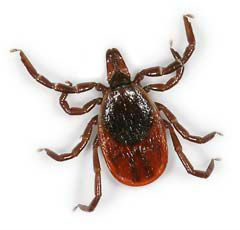
Ticks
It’s finally the time of year when everyone begins to slowly emerge from the proverbial woodwork, stows the hats, gloves, ice scrapers (and the rest of the fun cold-weather accouterments) and starts making plans to enjoy the mild weather. With all the anticipation and excitement surrounding the changing of seasons, we vividly remember 2017/2018, when a truly dangerous and annoying pest made an appearance (many times over).
2017 was a record-breaking year for ticks of all types across Connecticut. As the state came out of Winter, many local residents were appalled to discover the tiny eight-legged pest’s presence on almost any conceivable surface; on clothing, skin, carpets, etc. even after brief day-to-day interactions with the outdoors (like walking to the mailbox). Scientists at Western Connecticut State University (WCSU) proved it wasn’t just our imagination; citing a 300% increase in collected field samples from the previous year, and a staggering 1000% increase in numbers since 2014. Dr. Neeta Connally and her team concluded the study with the findings (taken at locations on Danbury, Newtown, and Ridgefield) at levels highest since sampling began in 2011.
We don’t wish to come off as alarmists, but there is some information that we feel pertinent to share, in order to help you keep your family safe, happy, and soaking up as many rays of Vitamin D from the Sun as possible.
Lyme disease is serious, and you may or may not be surprised to know that Connecticut has had the highest reported rate in the United States since 2001.
The disease usually infects human via Deer Tick bites. Deer ticks are very small and come in three forms (larvae, nymph, and adult). Of the three, the most concerning are the tiny, black-pepper sized nymphs which appear in April (conveniently when most folks typically begin showing their faces outside again).
Backing up a bit, why should we be concerned? Lyme disease takes 24 hours from the initial tick bite to begin transmitting infection. Shortly after, the infected individual may begin to experience flu-like symptoms, along with a bulls-eye shaped rash. Later on, the symptoms may include severe joint pains and swelling similar to arthritis, along with fatigue, memory loss and other neurological dysfunctions that can last for months on end. To make matters worse, diagnosis is often difficult and inaccurate in blood tests. The symptoms are similar to other diseases and Lyme is frequently misdiagnosed. Without going into every detail, it’s clear that this isn’t merely a “tick-transmitted cold”, but a truly debilitating illness with the potential to severely limit one’s activities, i.e destroy your plans for an epic Summer.
Now that we know how much of a damper it could put on an individuals livelihood, I would like to discuss prevention. It all starts at home, from thorough checks of all skin surfaces after being outside. Ultimately, prevention of exposure to these critters is the best way to maintain your potential plans. Additionally, YardScapes offers property treatment options via non-toxic cedar oil application, as well as strategically placed Damminix Tick Tubes.
Cedar oil can be sprayed around the perimeter of your lawn and woodline, as well as shrubs, walkways, and commonly traveled areas. The oil does not pose a health risk for humans or pets, but repels both ticks and mosquitos as they happen to dislike the pleasing woodsy scent. The oil also will kill the ticks should they happen to come in contact with it.
Tubes

Damminix tick tubes are a brilliant solution for tick control. These are biodegradable cardboard tubes filled with permethrin treated cotton balls. Carefully considered placement allows the actual host carrier of lyme disease (mice) to obtain the cotton material for use in nest building. Ticks feeding on the mice are eliminated by the mild insecticide, thus stopping the spread of disease at the host mammal’s home site.
Now that you have a basic understanding transmittal, progression and prevention the disease, we would be happy to assist in prolonging your enjoyment of the great outdoors.
Call us at 860-350-APES to take the first step in keeping your family and property safe from Lyme Disease.
For more information on Lyme Disease, please visit the CDC’s page here.
